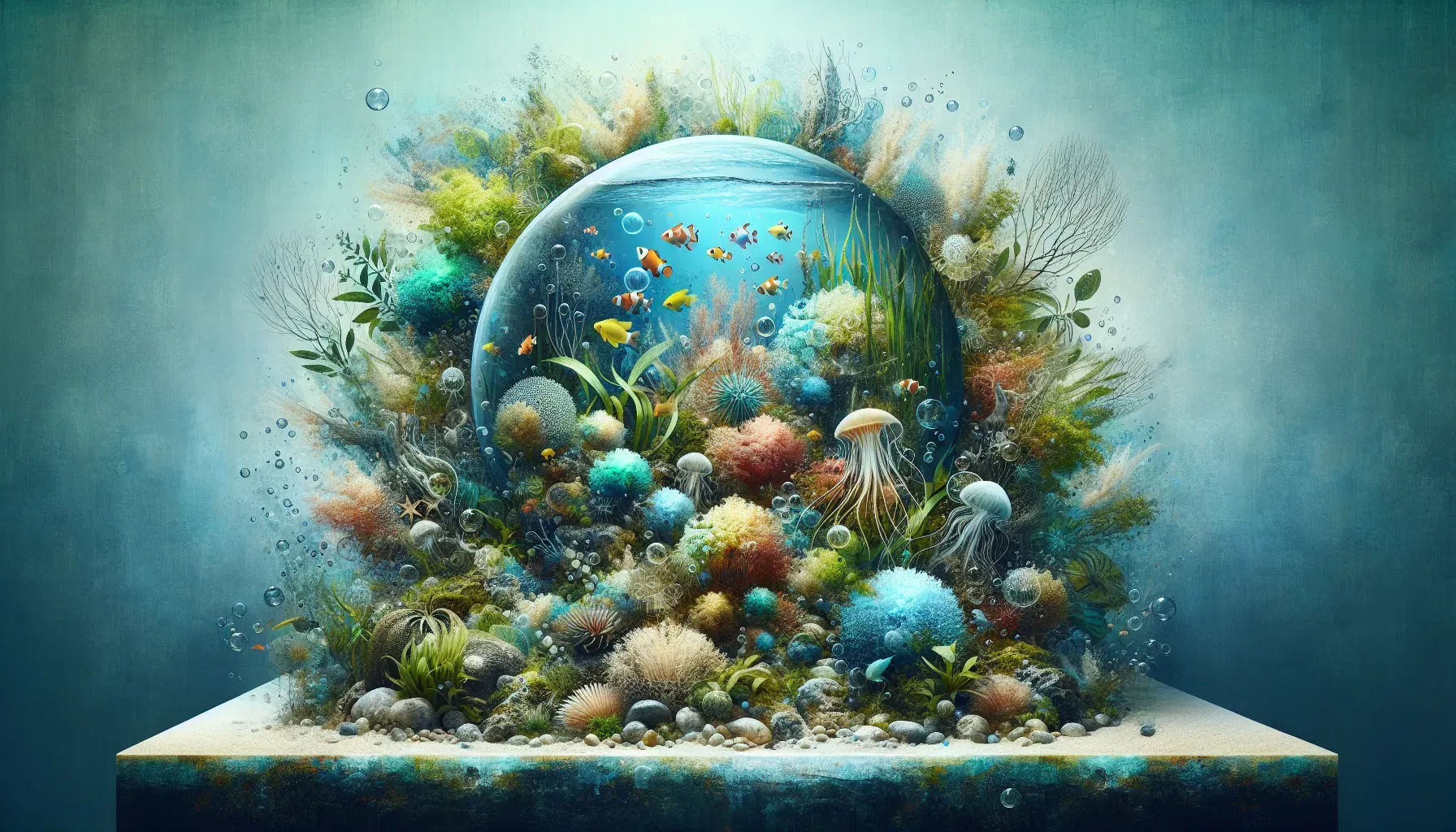Demystifying Aquatic Habitat Design: Creating Optimal Living Spaces for Aquarium Dwellers

Creating an ideal aquatic habitat for your aquarium inhabitants is a blend of art and science, requiring a deep understanding of the unique needs of each species. Tails' Talks emphasizes the importance of integrating these essential principles to ensure the health, happiness, and longevity of your aquatic pets. Let's delve deeper into each principle to provide a more comprehensive guide for aquarium enthusiasts.
Understanding Water Quality Requirements
Water quality is the cornerstone of a thriving aquatic habitat. It's not just about keeping the water clean; it's about ensuring the chemical composition supports the life within. These parameters are critical as even slight deviations can lead to stress or health issues for your aquatic dwellers. Establishing a strict maintenance routine, including partial water changes and filter maintenance, can preemptively solve many common water quality issues.
The right filtration system does more than just clean the water; it ensures the environment remains stable and conducive to your pets' health. Whether mechanical, biological, or chemical filtration, understanding the nuances of each system will allow you to create a balanced ecosystem where your aquatic pets can flourish.
Incorporating Adequate Filtration Systems
Adequate oxygenation and effective water circulation are vital for simulating a natural aquatic environment. We advise on carefully selecting air pumps and circulation devices that match the size of your aquarium and the needs of its residents. Proper circulation helps in distributing nutrients, maintaining even water temperatures, and ensuring that all areas of the tank are oxygenated efficiently, contributing significantly to the overall health of the aquatic ecosystem.
Balancing Oxygenation and Water Circulation
An aquarium is not just a habitat for your aquatic pets but also a living piece of art. We guide you through achieving a beautiful, functional space that caters to the needs of its inhabitants while enhancing your living space.
Balancing Aesthetics with Functional Requirements in Aquarium Design
The choice of substrate and décor goes beyond visual appeal, affecting the well-being and behavior of your aquarium's inhabitants. Selecting materials that reflect the natural environment of your aquatic pets, ensuring they feel at home. From sand substrates for bottom dwellers to rocky landscapes for cichlids, each choice should be informed by the species you intend to house.
Selecting Substrate and Décor Materials Wisely
Lighting influences not just the mood and visibility within the aquarium but also the biological rhythms and growth of plants and animals. Tailoring your lighting choices to the specific needs of your aquarium, balancing between aesthetic appeal and biological necessities. This includes understanding the light requirements of your plants and providing a natural day-night cycle for your fish, ensuring their health and vitality.
Choosing the right companions for your aquarium is a critical step in establishing a harmonious aquatic community. Tails' Talks brings to light the significance of thorough research and careful planning in mixing species with varying requirements and temperaments. Let's explore how to ensure compatibility and create a cohesive living environment for diverse aquatic species.
Proper Lighting for Healthy Aquatic Life
Understanding the intricacies of interspecies interactions is crucial for a peaceful aquarium. The importance of researching the social behaviors, dietary needs, and environmental preferences of each species you wish to introduce to your community tank. This knowledge is vital to prevent aggression, competition for food, and stress, ensuring a balanced ecosystem where all inhabitants can thrive.
To accommodate the diverse needs of multiple species in a single tank. These zones offer various microenvironments and hiding spots, allowing for territorial species to claim their space and more timid creatures to find refuge. By mimicking the complexity of natural habitats, you encourage natural behaviors and promote well-being among your aquatic pets.
Researching Species Compatibility
Replicating the natural habitats of your aquarium inhabitants not only makes for a visually stunning aquarium but also supports the psychological and physical health of its dwellers. Tails' Talks guides you through the steps to create a more engaging and naturalistic environment that enriches the lives of your aquatic pets.
Creating a slice of the natural world within your aquarium involves more than just aesthetic considerations; it's about providing a habitat that reflects the complexity and diversity of their wild counterparts. Aquarium enthusiasts should study the natural habitats of their pets, incorporating elements like plants, rocks, driftwood, and caves to recreate a familiar and comforting environment. This attention to detail not only enhances the visual appeal of your tank but also supports the natural behaviors and health of your aquatic inhabitants.
Creating Specified Zones within Your Aquarium
The inclusion of live plants in an aquarium goes beyond mere decoration; they play a crucial role in maintaining ecological balance. We highlight the benefits of live plants, such as oxygen production, toxin absorption, and providing shelter and breeding grounds for fish. Choosing the right plant species that are compatible with the water parameters and lighting conditions of your aquarium can significantly enhance the quality of life for your aquatic pets while adding to the natural beauty of their environment.
Envisioning Naturalistic Environments to Promote Aquatic Well-being
By applying these principles and strategies, you can create an enriching, naturalistic aquarium that not only captivates the eye but also promotes the health and happiness of its inhabitants. Whether you're a seasoned aquarist or a newcomer to the hobby, these guidelines will help you design a living aquatic masterpiece that thrives under your care.
Emulating Natural Landscapes in Your Aquarium
Taking your aquarium design to the next level involves delving into more advanced considerations that can significantly impact the well-being of your aquatic community.
Introducing Live Plants for Added Benefits
Creating a conducive environment for breeding specific species requires an understanding of their unique reproductive needs and behaviors. We suggest adjusting water parameters, lighting, and the aquarium landscape to mimic the natural breeding conditions of the species you wish to propagate. This might include providing secluded areas for spawning, adjusting water temperatures, or simulating rainy season conditions. These adjustments can encourage natural breeding behaviors, leading to a more engaged and vibrant aquatic community.
Embracing technology can greatly enhance the management and enjoyment of your aquarium. These tools not only make maintaining your aquarium more efficient but also allow for precise control over the environment, ensuring optimal conditions for your aquatic inhabitants at all times.
Advanced Considerations for Aquatic Habitat Design
Sustainability in aquarium design is about creating environments that are not only beautiful and biologically rich but also environmentally responsible.
Tailoring Environments for Breeding Success
We underscore the importance of ethically sourcing fish, plants, and other aquatic life. This means choosing suppliers who practice sustainable harvesting and breeding methods, which helps protect natural populations and habitats. By supporting responsible suppliers, aquarists contribute to the conservation of aquatic biodiversity and the sustainability of the hobby.
Integrating Advanced Technological Solutions in Aquariums
Minimizing the environmental impact of your aquarium involves adopting eco-friendly maintenance practices. We recommend using energy-efficient equipment, such as LED lighting and low-energy pumps, which reduce electricity consumption. Additionally, opting for natural methods of water purification, such as live plants and biological filtration, can decrease the need for chemical treatments, further aligning your aquarium practices with environmental sustainability.
By incorporating these advanced and sustainable practices into your aquatic habitat design, you enrich the lives of your aquarium inhabitants and contribute positively to the broader ecosystem.
Sustainable Practices in Aquatic Habitat Design
This approach not only elevates the art and science of aquarium keeping but also fosters a deeper connection between aquarists and the natural world, ensuring a rewarding and responsible engagement with this fascinating hobby.
Ethical Sourcing of Aquatic Life for Your Aquarium
In conclusion, creating an optimal living space for aquarium dwellers goes beyond basic care to encompass a holistic approach that considers the physical, psychological, and environmental needs of aquatic species. By following the comprehensive guidelines provided by Tails' Talks, aquarists are equipped to design enriching, naturalistic habitats that promote the well-being of their aquatic pets while also embracing sustainability and ethical practices in the hobby.
From understanding the fundamental principles of water quality and filtration to incorporating advanced technological solutions and sustainable practices. This journey not only enhances the health and vibrancy of your aquarium but also contributes to the conservation of aquatic ecosystems and species.
Remember, a well-designed aquarium is a living ecosystem that provides a glimpse into the fascinating underwater world. It requires commitment, knowledge, and a passion for aquatic life.
Whether you are a seasoned aquarist or a newcomer to this rewarding hobby, we hope this guide inspires you to explore the depths of aquatic habitat design with a renewed sense of purpose and creativity. Tails' Talks is here to support your journey, offering expert advice and inspiration every step of the way.
Frequently Asked Questions
Proper lighting in an aquarium is essential as it influences the mood, visibility, and biological rhythms of both plants and animals. Tailoring your lighting choices to meet the specific needs of your aquatic life ensures a natural day-night cycle, promoting health and vitality. This balance between aesthetics and biological requirements is crucial for a thriving ecosystem.
Live plants play a vital role in maintaining ecological balance within an aquarium. They produce oxygen, absorb toxins, and provide shelter and breeding grounds for fish. Choosing compatible plant species that thrive under your aquarium's water parameters and lighting conditions can significantly enhance the quality of life for your aquatic pets while adding natural beauty to their habitat.
Eco-friendly aquarium maintenance involves using energy-efficient equipment like LED lighting and low-energy pumps to reduce electricity consumption. Additionally, employing natural methods of water purification, such as biological filtration and live plants, minimizes the need for chemical treatments. These practices not only lower environmental impact but also promote a healthier ecosystem for your aquatic inhabitants.
Creating optimal living spaces for aquarium dwellers is crucial as it encompasses their physical, psychological, and environmental needs. A well-designed habitat promotes health, happiness, and longevity among aquatic species. By following comprehensive guidelines on habitat design, aquarists can ensure their pets thrive while fostering a deeper connection with the underwater world.
To ensure compatibility among different species in your aquarium, it's essential to research their social behaviors, dietary needs, and environmental preferences. Understanding these factors helps prevent aggression and competition for resources. Creating specified zones within the tank can also accommodate territorial species while providing refuge for more timid inhabitants, promoting a harmonious community.
The key principles of aquatic habitat design include understanding water quality requirements, incorporating adequate filtration systems, balancing oxygenation and water circulation, and selecting appropriate substrate and décor materials. These principles ensure a stable environment that supports the health and well-being of aquatic pets while creating an aesthetically pleasing display.






